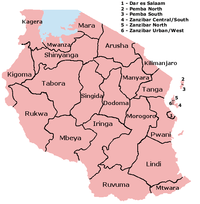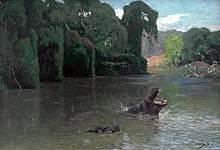Ulanga River
The Ulanga River, also known as the Kilombero River, is a river that starts in the southwest of Tanzania on the eastern slope of the East African Rift that flows northeast into the Rufiji River then to the Indian Ocean.
| Designations | |
|---|---|
| Official name | Kilombero Valley Floodplain |
| Designated | 25 April 2002 |
| Reference no. | 1173[1] |
Geology
The Ulanga Valley is an intact natural wetland ecosystem comprising myriad rivers, which make up the largest seasonally freshwater lowland floodplain in East Africa. The Ulanga River supplies ⅔ of the Rufiji waters.[2]
The Ulanga river is formed by the convergence of major rivers coming from the south, that flow north from the mountain ranges of the Njombe and Iringa regions on the eastern slope of the East African Rift and south from the Udzungwa Mountains and Mahenge Mountains. From south the Ruhudji River winds eastward, losing height quite rapidly, to the head of the great floodplain of the Ulanga Valley. The floodplain occupies the flat floor of the Ulanga Valley at 210–250 m.a.s.l. The valley is oriented south-west north-east, between densely forested escarpments in the Udzungwa Mountains, which tower at 2,250 meters above the valley floor (7°47′0″S 36°36′0″E), on the north-western side and the Mahenge Mountains on the southern side (8°45′0″S 36°39′0″E). The Ruhudji receives several important tributaries and then divides on the floodplain into a number of channels, which produce a network in the central part of the floodplain. Other affluents draining the mountains on opposing sides of the valley join the network so that in the central part there are ten major channels flowing roughly in parallel. A zone of permanent swamps, 45 km long, extends up to 4 km away from the west bank of the Kihansi River. The Kihansi was dammed in its upstream ranges above the Kihansi Gorge in 1995. The southern central parts of the floodplain descend 40 meters over a distance of 210 km. At Ifakara the valley narrows in to be about 4 km wide and the rivers are united into the main stream of the Ulanga River. East of Ifakara the Ulanga flows through a delta of oxbow lakes and is joined on its left bank by the Msolwa River. This stream comes from the high escarpment of the Udzungwas and traverses the northern part of the floodplain, skirting another zone of permanent swampland to the west. From the point of confluence the Ulanga River swings sharply southeast and leaves the floodplain (and the Ramsar Site) on the border of the Selous Game Reserve. The Ulanga River then continuous for 65 km to confluence with the Luwegu where they merge at the Shuguli Falls to become the Rufiji River. The Rufiji then flows northeast through the Selous Game Reserve on its way to the Indian Ocean.[3][4]
History
Starting in 1885, Karl Peters had begun claiming areas of East Africa for Germany. The Tanganyikan coast proved relatively easy, but conquest of the inland areas of the colony—right up to the Belgian Congo—was more difficult as large parts were still unexplored. For this reason, Governor Gustav Adolf von Götzen led an expedition to claim these hinterlands. He took with him Georg von Prittwitz and Hermann Kersting.[5][6][7]
The Ulanga river and of its tributary the Kihansi were first surveyed in 1897-98 by von Prittwitz in an attempt to determine whether either river would afford a navigable waterway from the coast to the mountainous district of Uhehe. From Perondo von Prittwitz navigated the Kihansi in a canoe, determining that the Kihansi was too difficult to navigate due to the great number of sharp curves with narrow channel obstructed by hippopotami. The Ulanga with its broad smooth curves was easy to navigate by a light-draught steamer.[8]
Political & Economic

The Ulanga River forms the boundary between the Ulanga District and Kilombero District of the Morogoro Region in the southwest of Tanzania.
The majority of the villagers in the Ulanga Valley are subsistence farmers of maize and rice, though many make a living fishing. There are large plantations of teak wood in the Ulanga valley. In the north-west of the district, Illovo Sugar Company's sugar-cane plantations occupy most of the lowlying area.[9][10][11]
Wildlife
The Ulanga Valley is characterized by its large populations of large mammals such as the buffalo, elephant, hippopotamus, lion, and puku. The majority of the world's Puku population live in the Ulanga Valley. The Ulanga Valley is home to one of the largest populations of Nile crocodile in Africa and is an important breeding ground for bird species such as the African openbill, white-headed lapwing, and the African skimmer. The Ulanga Valley is also home to a number of species only found in the Valley, such as the Udzungwa red colobus monkey and three species of birds, the Ulanga weaver and two undescribed species of cisticolas.[2][12][13][14][15][16][17]
The Ulanga river is home to 23 species of fish that are caught on a regular basis including three species of fish not found downstream in the Rufiji: Alestes stuhlmannii and two species of Citharinus congicus. Fish from the Rufiji River system migrate upstream to the Ulanga to spawn, usually at the beginning of the rains in November with peak spawning activity coming in December period.[18][19]
In popular culture

The eponymous boat in C.S. Forester's novel The African Queen (1935) and its subsequent film adaptation (1951) was a steam-powered launch, owned by a Belgian mining corporation, that plied the upper reaches of the Ulanga River.
Animal painter Friedrich Wilhelm Kuhnert featured the Ulanga River in his painting The Gallery of Trees Ulanga River.
See also
References
- "Kilombero Valley Floodplain". Ramsar Sites Information Service. Retrieved 25 April 2018.
- "Information Sheet on Ramsar Wetlands" (PDF). Dar es Salaam: United Republic of Tanzania, Director of Wildlife, Wildlife Division, Ministry of Natural resources and Tourism. 2002-06-19. Cite journal requires
|journal=(help) - Andreas Wildner; et al. "Rufiji River". Retrieved 2010-05-14.
- Hughes, R.H. & Hughes, J. S. 1992. A Directory of African Wetlands. IUCN, UNEP, WCMC.
- Gustav Adolf von Götzen (1895). Durch Afrika von Ost nach West. Berlin: D. Reimer. p. 1.
Gustav Adolf von Götzen.
- Deutsch-Ostafrika im Aufstand 1905/06. Berlin. 1909.
- Reinhart Bindseil (1992). Ruanda im Lebensbild des Offiziers, Afrikaforschers und Kaiserlichen Gouverneurs Gustav Adolf Graf von Götzen (1866—1910). Mit einem Abriss über die zeitgenössischen Forschungsreisenden Franz Stuhlmann, Oscar Baumann, Richard Kandt, Adolf Friedrich Herzog zu Mecklenburg und Hans Meyer. Berlin. ISBN 3-496-00427-4.
- Royal Geographical Society of Great Britain (1899). The Geographical journal, Volume 13. London: Royal Geographical Society. pp. 660–661.
- Corti, Graham, Fanning, Eibleis, Hinde, Roy, and Jenkins, Richard, 1999. A Conservation Assessment the Amphibian Communities of Miombo Woodland, Evergreen Forest and a Teak (I'ectona Grandis) Plantation in the Ulanga Valley, Tanzania (Technical Report 3). Frontier-Tanzania Savanna Research Programme, Dar es Salaaml
- Hinde, R., Corti, G., Fanning, E., & Jenkins, R., 1999a, A conservation assessment of large mammal use of miombo woodland, evergreen forest and a teak plantation in the Ulanga Valley, Tanzania, Frontier Tanzania Savanna Research Programme, Technical Report No. 2., unpublished, Frontier Tanzania, Dar es Salaam, Tanzania.
- Jenkins R., Roettcher, K, Corti, G & Fanning, E, 2000a, Large mammals and teak plantations in the Ulanga Valley, Annual Report, unpublished, Frontier Tanzania, Dar es Salaam, Tanzania.
- Games I., & Severre E. L. M., 1999, Tanzanian crocodile survey, October 1999, A report to the Director of Wildlife, Tanzania
- Dinesen, L., Lehmberg, T., Rahner, M. & Fjeldsa, J. 2001. Conservation priorities for the forests of the Udzungwa Mountains, Tanzania, based on primates, duikers and birds. Biological Conservation 99:223-236.
- Stattersfield, A. J., Crowby, M.J., long, A. J., Wege, D. C. 1998. Endemic Bird Areas of the World. Priorities for Biodiversity Conservation. BirdLife International, Cambridge UK. Tanzania Country Study on Biological Diversity 1998. Sponsored by UNEP, GEF, NORAD. Government of the United Republic of Tanzania, Vice Presidents Office.
- Baker, N. 1996. Tanzania Waterbird Count - The first coordinated count on the major wetlands of Tanzania. For Wildlife Conservation Society of Tanzania/BirdLife Tanzania.
- Jenkins, R, Roettcher, K, Corti, G & Fanning, E, 2000b, The Ulanga River Fishery, Annual Report, unpublished, Frontier Tanzania, Dar es Salaam, Tanzania.
- Rainey, H., Birnie, N., Cameron, A., Mwangomo, E., Starkey, M. 2000. Bird Survey in Ulanga Valley in 1997. Umpublished report.
- RUBADA, 1981, Rufiji Basin Study Programme. Study of fisheries in the proposed Steiglers gorge reservoir and the Ulanga floodplain. Atkins land and water management, Cambridge, England.
- Charlwood, J, D., and Utzinger, Jurg, 1997. Fishery Methods and Fish Diversity in the Ulanga River in South-Eastern Tanzania. Afr. J. Hydrobiol. Fish Vol, No 7, p. 55-64.